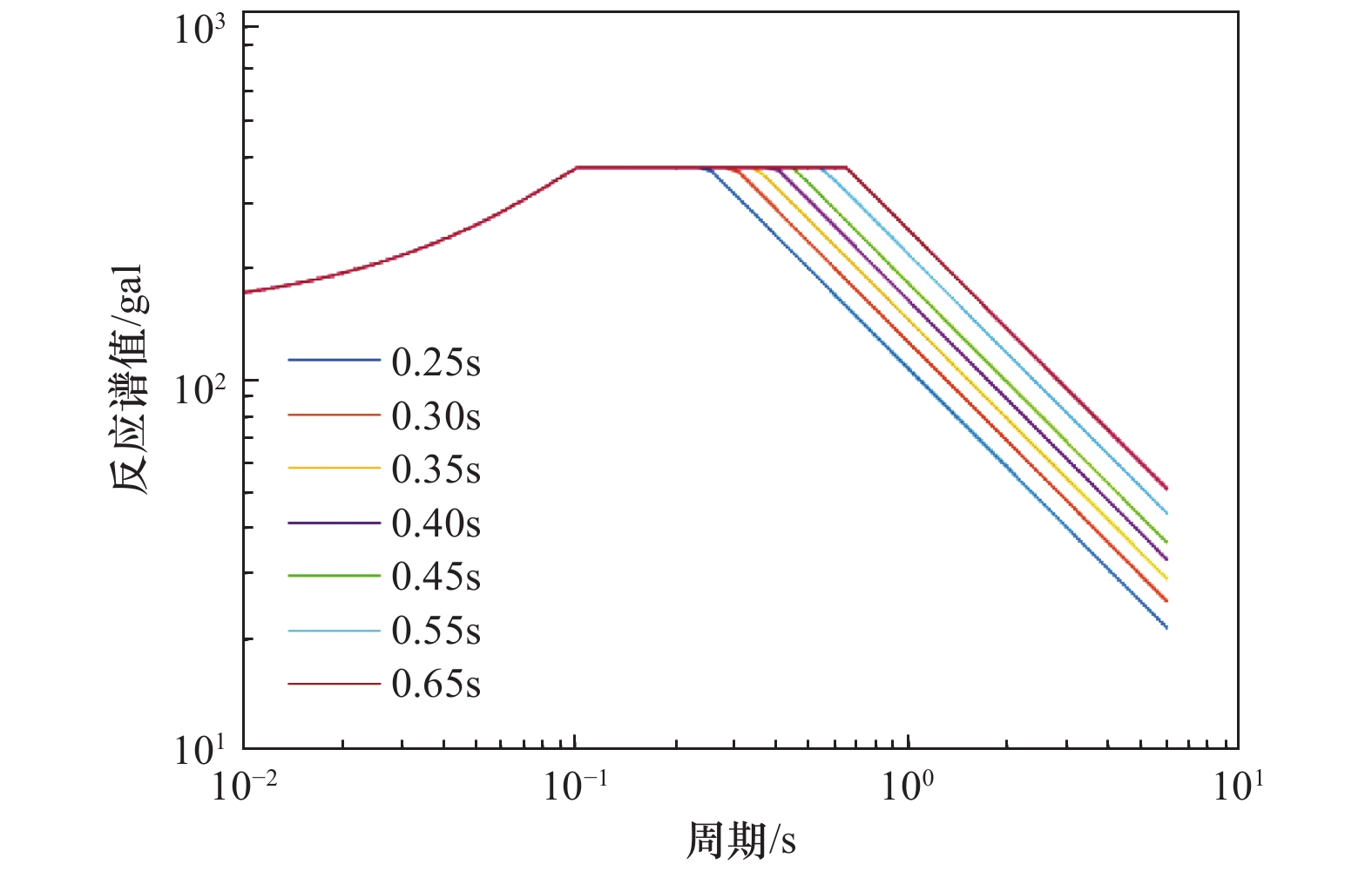Study on the Change of Earthquake Ground Motion Parameters for Different Classification Sites of Ocean Areas
-
摘要: 基于海域场地分类标准,选取南海海域实测钻孔作为计算模型,同时人工构造部分钻孔计算模型,对126条不同特性地震动输入下5种类别场地计算模型开展土层反应分析计算,分析不同地震动输入下不同海域场地峰值加速度和特征周期变化规律。结果表明,场地类别和地震动输入强度显著影响峰值加速度放大系数和特征周期,场地土越软,地震动输入强度越大,峰值加速度放大系数越小,特征周期越大。根据研究结果给出不同地震动输入下不同海域场地峰值加速度放大系数、特征周期变化范围,为海域场地工程抗震设防和编制海域地震动参数区划图提供参考。Abstract: Based on site classification standards for ocean areas, the boreholes in the South Sea of China are selected as calculation model for site response. Due to the insufficiency of ocean geological data, some boreholes are also constructed for site response. By using 126 ground motions with different characteristics, site response was conducted for 5 kinds of classification sites. The change of peak acceleration and characteristic period under different input motions for different site classifications is analysized. Results show that site classifications and peak acceleration of input ground motion greatly influenced the amplification coefficients of peak acceleration and characteristic periods. The conclusion are as follows: amplification coefficient becomes smaller and characteristic period becomes longer when the site goes softer and input motion goes stronger. The variation range of amplification coefficients and characteristic periods under different input motions and site classifications are concluded. The results can be inferred to anti-seismic design of ocean engineering structures and to the earthquake ground motion parameters zonation of ocean areas.
-
表 1 海域场地分类标准
Table 1. Site classification standards for ocean areas
项目 沉积年代/厚度 Q3 Q4/H≤40 m Q4/40<H≤60 m Q4/60<H≤100 m Q4/H>100 m 40 m等效剪切波速Vse/m·s−1 Vse>500 350<Vse≤500 290<Vse≤350 240<Vse≤290 190<Vse≤240 Vse<190 场地类别 Ⅰ0 Ⅰ1 Ⅱ Ⅲ Ⅳ Ⅴ 表 2 Ⅴ类场地计算模型
Table 2. Calculation model for V classification site
土层序号 土层描述 非线性特性土样编号 土层深度/m 层厚/m 波速Vs/(m·s−1) 密度/(kg·m−3) 1 非常软的粉质黏土至砂质黏土 S-18A 0.0~2.0 2.0 100 1 880 2 松散细砂 S-6A 2.0~5.2 3.2 136 1 892 3 密实的细砂至中砂 S-11A 5.2~12.7 7.5 170 1 898 4 稍硬的粉质黏土和粉土质砂互层 S-15B 12.7~14.8 2.1 196 2 000 5 稍硬至硬的粉质黏土 S-18A 14.8~17.8 3.0 210 1 904 6 密实的细砂 S-26B 17.8~28.0 10.2 220 1 900 7 密实至非常密实的细砂 S-26B 28.0~44.0 16.0 225 2 000 8 硬至非常硬的粉质黏土 S-41A 44.0~51.4 7.4 395 2 000 9 中密至密实的粉土质细砂 S-41A 51.4~60.6 9.2 298 1 970 10 密实至非常密实的细砂至中砂 S-53 60.6~72.5 11.9 416 1 920 11 硬至非常硬的粉质黏土 S-55C 72.5~76.0 3.5 468 2 045 12 密实的细砂至中砂 S-57 76.0~87.3 11.3 389 1 908 13 非常硬粉质黏土和砂质粉砂互层 S-60C 87.3~89.4 2.1 401 1 955 14 砂质粉土与粉质黏土迭层 S-61B 89.4~93.1 3.7 427 1 950 15 密实的细砂至粗砂 S-57 93.1~98.5 5.4 478 2054 16 硬至非常硬的粉质黏土和密实的粉砂、粉质细砂叠层 S-66A 98.5~114.6 16.1 449 1 900 17 非常密实的细砂至粗砂 S-57 114.6~120.2 5.6 490 2 000 18 计算基底 — 120.2 — 500 2 000 表 3 Ⅰ1类场地钻孔计算模型
Table 3. Calculation model for Ⅰ1 classification site
土层序号 土层描述 非线性特性土样编号 土层深度/m 层厚/m 波速Vs/m·s−1 密度/kg·m−3 1 密实的细砂 S-26B 0.0~5.0 5.0 240 1 900 2 密实至非常密实的细砂 S-26B 5.0~10.0 5.0 273 2 000 3 中密至密实的粉土质细砂 S-41A 10.0~15.0 5.0 298 1 970 4 硬至非常硬的粉质黏土 S-41A 15.0~20.0 5.0 395 2 000 5 密实至非常密实的细砂至中砂 S-53 20.0~25.0 5.0 416 1 920 6 硬至非常硬的粉质黏土 S-55C 25.0~30.0 5.0 468 2 045 7 密实的细砂至粗砂 S-57 30.0~35.0 5.0 478 2054 8 非常密实的细砂至粗砂 S-57 35.0~40.0 5.0 490 2 000 9 计算基底 — 40.0 — 500 2 000 4a Ⅰ1类场地峰值加速度放大系数
4a. Amplification coefficient of peak acceleration for Ⅰ1 classification site
特征周期/s 峰值加速度/gal 50 100 150 样本1 样本2 样本3 样本1 样本2 样本3 样本1 样本2 样本3 0.25 1.39 1.55 1.33 1.35 1.43 1.25 1.24 1.34 1.26 0.30 1.39 1.32 1.43 1.26 1.30 1.37 1.33 1.27 1.30 0.35 1.58 1.44 1.35 1.37 1.44 1.41 1.27 1.27 1.27 0.40 1.47 1.62 1.41 1.33 1.39 1.28 1.35 1.24 1.35 0.45 1.36 1.31 1.39 1.33 1.35 1.49 1.35 1.43 1.33 0.55 1.45 1.45 1.36 1.26 1.35 1.32 1.48 1.32 1.37 0.65 1.34 1.44 1.44 1.32 1.48 1.40 1.35 1.35 1.35 4b Ⅰ1类场地峰值加速度放大系数
4b. Amplification coefficient of peak acceleration for Ⅰ1 classification site
特征周期/s 峰值加速度/gal 200 300 400 样本1 样本2 样本3 样本1 样本2 样本3 样本1 样本2 样本3 0.25 1.38 1.27 1.14 1.29 1.21 1.13 1.16 1.34 1.18 0.30 1.36 1.37 1.29 1.20 1.12 1.29 1.26 1.09 1.32 0.35 1.39 1.17 1.35 1.32 1.34 1.21 1.34 1.19 1.18 0.40 1.33 1.29 1.37 1.27 1.33 1.27 1.33 1.13 1.34 0.45 1.35 1.41 1.32 1.24 1.47 1.31 1.32 1.27 1.11 0.55 1.41 1.35 1.33 1.32 1.21 1.27 1.26 1.30 1.29 0.65 1.34 1.29 1.21 1.27 1.27 1.29 1.27 1.26 1.26 表 5 不同类别场地峰值加速度放大系数
Table 5. Statistical charts of peak acceleration amplification coefficient for different classification sites
场地类别 峰值加速度/gal 50 100 150 200 300 400 Ⅰ1 变化范围 1.31~1.62 1.25~1.49 1.24~1.48 1.14~1.41 1.12~1.47 1.09~1.34 均值 1.42 1.36 1.32 1.32 1.27 1.25 Ⅱ 变化范围 1.22~1.60 1.05~1.35 1.06~1.52 1.06~1.36 1.08~1.34 1.03~1.31 均值 1.38 1.23 1.20 1.23 1.19 1.18 Ⅲ 变化范围 1.12~1.49 1.10~1.43 0.98~1.30 0.91~1.24 0.79~1.18 0.74~1.04 均值 1.26 1.21 1.13 1.05 0.92 0.91 Ⅳ 变化范围 1.05~1.41 0.99~1.47 0.87~1.25 0.84~1.31 0.65~1.03 0.53~1.10 均值 1.25 1.19 1.07 1.03 0.85 0.82 Ⅴ 变化范围 1.05~1.37 0.97~1.47 0.81~1.20 0.80~1.11 0.61~1.07 0.5~1.03 均值 1.24 1.18 1.07 0.98 0.75 0.70 表 6 Ⅰ1类场地反应谱特征周期
Table 6. Characteristic period of acceleration response spectrum for Ⅰ1 classification site
特征周期/s 峰值加速度/gal 50 100 150 200 300 400 0.25 0.30 0.30 0.30 0.30 0.35 0.35 0.30 0.35 0.35 0.35 0.35 0.40 0.40 0.35 0.40 0.40 0.40 0.40 0.45 0.45 0.40 0.45 0.45 0.45 0.45 0.45 0.50 0.45 0.50 0.50 0.50 0.50 0.50 0.55 0.55 0.60 0.60 0.60 0.60 0.60 0.65 0.65 0.70 0.70 0.70 0.70 0.70 0.75 表 7 不同类别场地地表反应谱特征周期
Table 7. Characteristic period of acceleration response spectrum for different classification sites
输入地震动特征周期/s 场地类别 Ⅰ1 Ⅱ Ⅲ Ⅳ Ⅴ 0.25 变化范围 0.30~0.35 0.30~0.35 0.35~0.40 0.45~0.55 0.40~0.90 均值 0.32 0.34 0.37 0.51 0.63 0.30 变化范围 0.35~0.40 0.35~0.45 0.40~0.50 0.50~0.60 0.50~1.00 均值 0.37 0.41 0.47 0.57 0.74 0.35 变化范围 0.40~0.45 0.40~0.50 0.45~0.60 0.55~0.70 0.55~1.10 均值 0.42 0.46 0.52 0.62 0.79 0.40 变化范围 0.45~0.50 0.45~0.55 0.50~0.65 0.65~0.75 0.65~1.20 均值 0.46 0.51 0.61 0.72 0.85 0.45 变化范围 0.50~0.55 0.50~0.60 0.55~0.75 0.70~0.90 0.70~1.30 均值 0.51 0.55 0.64 0.81 0.88 0.55 变化范围 0.60~0.65 0.60~0.70 0.65~0.90 0.80~0.90 0.80~1.50 均值 0.61 0.65 0.74 0.86 0.95 0.65 变化范围 0.70~0.75 0.70~0.80 0.75~1.00 0.90~1.10 0.90~1.80 均值 0.71 0.75 0.86 0.98 1.2 -
[1] 李小军, 2006. 海域工程场地地震安全性评价的特殊问题. 震灾防御技术, 1(2): 97—104. doi: 10.3969/j.issn.1673-5722.2006.02.002Li X. J., 2006. Special problems on evaluation of seismic safety for offshore engineering site. Technology for Earthquake Disaster Prevention, 1(2): 97—104. (in Chinese) doi: 10.3969/j.issn.1673-5722.2006.02.002 [2] 李小军, 陈苏, 任治坤等, 2020. 海域地震区划关键技术研究项目及研究进展. 地震科学进展, 50(1): 2—19. doi: 10.3969/j.issn.2096-7780.2020.01.001Li X. J., Chen S., Ren Z. K., et al., 2020. Project plan and research progress on key technologies of seismic zoning in sea areas. Progress in Earthquake Sciences, 50(1): 2—19. (in Chinese) doi: 10.3969/j.issn.2096-7780.2020.01.001 [3] 李小军, 陈苏, 彭艳菊等, 2021. 海域地震动传播规律及场地影响模型研究. 北京: 中国地震局地球物理研究所. [4] 陆鸣, 王笃国, 李峰等, 2003. 陆丰13-2ODP平台工程场址及管线路由地震危险性分析. 北京: 中国地震局地震工程研究中心. [5] 陆鸣, 王笃国, 李峰等, 2005. 西江23-1油田工程场址地震危险性分析报告. 北京: 中国地震局地震工程研究中心. [6] 潘华, 陈国兴, 孙田, 2011. 原状海洋土动泊松比的试验研究. 岩土力学, 32(S1): 346—350.Pan H., Chen G. X., Sun T., 2011. Experimental research on dynamic Poisson’s ratio of undisturbed marine soil. Rock and Soil Mechanics, 32(S1): 346—350. (in Chinese) [7] 荣棉水, 李小军, 2014. 渤海海域软表层土的动力特性. 哈尔滨工程大学学报, 35(7): 833—838.Rong M. S., Li X. J., 2014. The dynamic characteristics of soft topsoil in the Bohai sea area. Journal of Harbin Engineering University, 35(7): 833—838. (in Chinese) [8] 孙田, 陈国兴, 周恩全等, 2013. 琼州海峡100 m以浅海洋土动剪切模量比和阻尼比试验研究. 岩土工程学报, 35(S2): 375—382.Sun T., Chen G. X., Zhou E. Q., et al., 2013. Experimental study on dynamic shear modulus ratio and damping ratio of marine soils in Qiongzhou strait with depth less than 100 m. Chinese Journal of Geotechnical Engineering, 35(S2): 375—382. (in Chinese) [9] 王炳辉, 陈国兴, 王晶华, 2007. 宁波近海沉积土动力特性的试验研究. 自然灾害学报, 16(4): 55—60. doi: 10.3969/j.issn.1004-4574.2007.04.009Wang B. H., Chen G. X., Wang J. H., 2007. Experimental study on dynamic characteristics of Ningbo’s offshore sediment soils. Journal of Natural Disasters, 16(4): 55—60. (in Chinese) doi: 10.3969/j.issn.1004-4574.2007.04.009 [10] Hu J. J., Tan J. Y., Zhao, J. X., 2020. New GMPEs for the Sagami bay region in Japan for moderate magnitude events with emphasis on differences on site amplifications at the seafloor and land seismic stations of K-NET. Bull. Bulletin of the Seismological Society of America, 110(5): 2577—2597. doi: 10.1785/0120190305 [11] Idriss I. M., 1992. A computer program for conducting equivalent linear seismic response analysis of horizontally layered soil deposits modified based on the original SHAKE program published in December 1972 by Schnabel, Lysmer and Seed. Shake. -




 下载:
下载:



